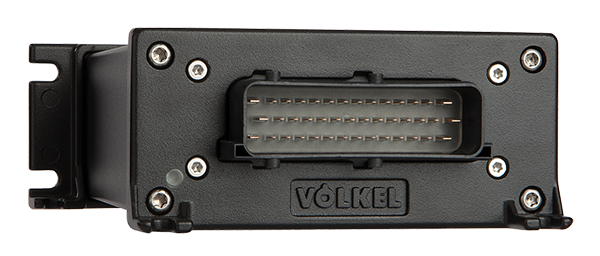Drive control with traction control
HCE-DCT(Drive Control Traction)
The drive control with traction control DCT has been developed for vehicles that need to be moved with as little slip to the ground as possible.
Functions:
- Basic driving functions
- Various modes and parameter sets
- Driving depending on the diesel speed, control of variable displacement pump and engine
- limit load control
- Speed, brake pressure, constant pressure regulator
- Overspeed control, eco operating modes
- Anti-slip control for 4 wheels during acceleration and deceleration
- Coupling operation with several vehicles

Detailed information
The drive control with traction control DCT has been developed for vehicles that need to be moved with as little slip to the ground as possible.
While the DCT enables a driving style that is gentle on the soil in agricultural and forestry machines, it ensures a more stable driving style in high-speed municipal machines. For rail vehicles, driving with anti-skid and skid protection is even prescribed by the Federal Railway Authority. The DCT drive control is consistently designed to minimize hydraulic components such as flow dividers, pressure regulators, jetting, etc. in order to simplify the design of the machine. The DCT drive control therefore has all the functions of the ECO drive control. All controllers can be activated or deactivated via parameterization and adapted to the requirements of the current vehicle.
The standard hardware platform for the DCT is the HCE controller. If the DCT is to be integrated into a machine control system, it can easily be ported to another Völkel hardware platform.
The extended functions in detail:
Traction controller
The traction controller reduces the torque at the spinning or locked wheel. This is possible for up to 3 out of 4 wheels. Axle-by-axle control is also possible if axle motors are used instead of wheel motors. The output torque can be controlled to zero, taking into account the limit values of the hydraulic motors. Depending on the changed motor displacement, the pump delivery volume is compensated in order to avoid an unintentional change in speed. The controller has an integrated learning function for simplified adaptation to different vehicles.
Controlled torque range selection
If closed-loop traction control is not required, DCT supports a controlled variant: the maximum torque available at the hydraulic motor is specified by the driver or the higher-level control system via an analog set value or a digitally selected fixed value. The drive control then works as a torque limiter, so that driving is also gentle on the ground. Unlike the closed-loop traction controller, this operating mode does not run continuously at the maximum possible torque.
Acceleration mode
The acceleration mode is a special function for rail vehicles. If it is activated, the set value of the drive lever is not a measure of the target speed, but of the acceleration of the vehicle. If the drive lever remains in the center position, the vehicle maintains the current speed. A safety drive circuit (SIFA, dead man’s switch) must always be activated in parallel with the acceleration mode.
Coupling operation of several vehicles
If several vehicles with hydrostatic drive are coupled, hydraulic tensioning must be avoided so that one vehicle in the combination is not towed or pushed by the others. Driving pressure control ensures that each hydraulic circuit makes a positive contribution to propulsion. The same applies to rail vehicles that have one hydraulic circuit per bogie.
Extended ECO mode
The DCT drive control offers the option of interacting with the working hydraulics control. This means that the diesel engine can be controlled as required and also operated at the load edge, taking into account the working hydraulics. The prioritization of the components in the different operating modes is controlled by the DCT.
AdBlue and soot particle management
If the diesel engine is operated at the optimum operating point, the consumption of AdBlue is lower and the soot particle filter becomes clogged more slowly. If it is not possible to operate the machine in this way due to external circumstances, measures must be taken by the machine control system. Together with a Völkel display, the advanced diesel management of modern engines is supported. Depending on the AdBlue tank level and the condition of the particulate filter, the engine output is limited or regeneration is carried out, for example.
E1 Type approval
The DCT control hardware platform has E1 type approval so that the machine can be approved for use on European roads.

Control unit: HCE / Application: DCT (Drive Control Traction)

What can we do for you?
Get in touch

Dirk Jansen Dipl.-Ing. (FH)
Phone: +49 2534 9731-0
jansen@voelkel.de
Völkel Mikroelektronik GmbH
Otto-Hahn-Straße 30
48161 Münster
